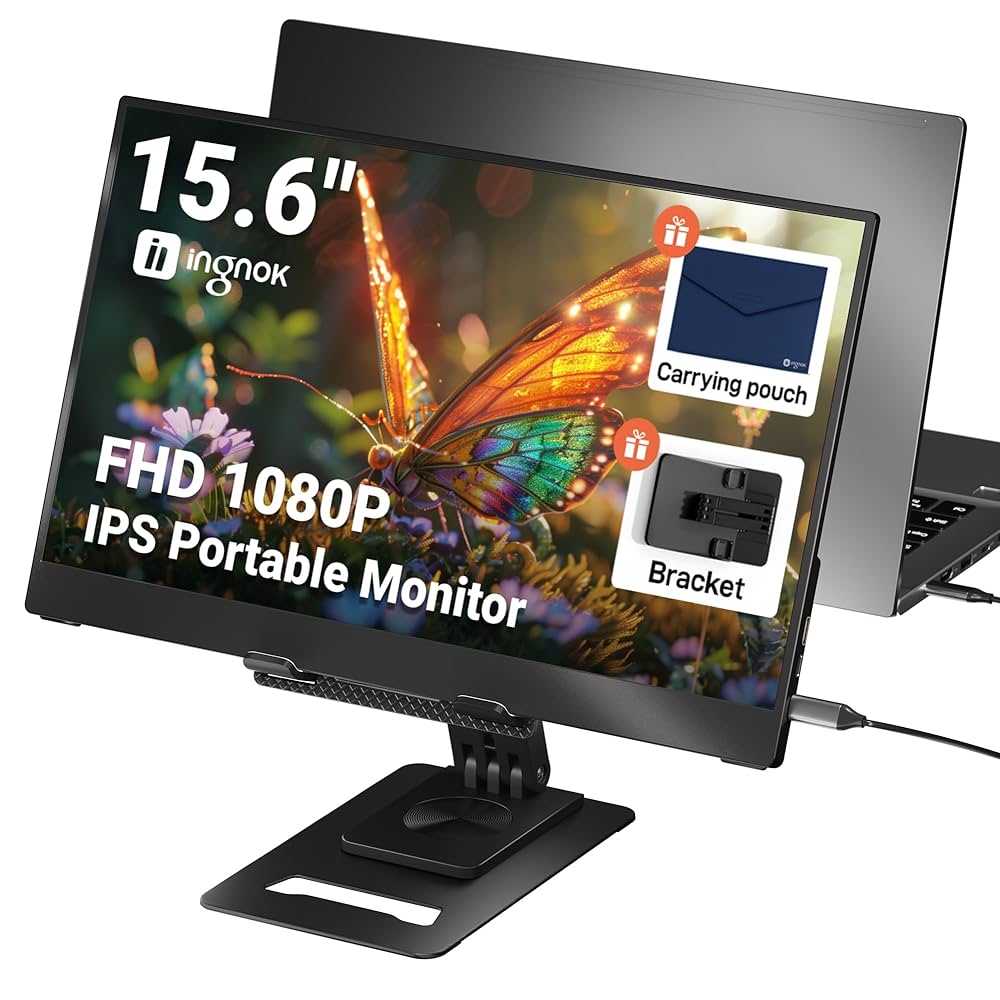To quickly check if your portable monitor will work with your device, ensure your device has the right ports, supports the necessary video standards, and that your operating system is compatible. Connect your devices or consult the manufacturer’s specifications to confirm compatibility. It’s straightforward once you know what to look for!
If you’re considering a portable monitor, the key to a smooth setup is verifying that your device supports the monitor’s connection type and specifications. Think about the ports on your laptop or smartphone—are they HDMI, USB-C, or DisplayPort? Then, check if your device’s video output standards match those of the monitor. Finally, ensure your device’s operating system can handle external displays. Doing these simple steps beforehand can save you a lot of frustration and help you enjoy your portable monitor hassle-free.
Getting a portable monitor is a game-changer for remote work, gaming, or extra screen space on the go. But before making a purchase, it’s essential to verify compatibility to avoid disappointment. Many people overlook the importance of matching ports, video standards, and OS support, which can lead to connection issues or subpar performance. Checking these aspects is simple but crucial for a seamless experience. With a little quick research—reviewing your device’s specs and the monitor’s requirements—you can confidently select a portable monitor that fits perfectly into your tech setup. This way, you’ll enjoy the added convenience and flexibility without any hiccups.
How to Check Compatibility of Portable Monitor
Before buying a portable monitor, it’s essential to verify if it works well with your devices. Compatibility ensures that the monitor will connect smoothly and function properly. This section guides you step-by-step on how to determine if a portable monitor is compatible with your laptop, tablet, or smartphone.
Understanding Connection Types
Portable monitors come with different connection options. The most common are USB-C, HDMI, and DisplayPort. Knowing which connection type your device supports is crucial to choosing the right monitor.
USB-C Connection
Many modern portable monitors use USB-C ports for both power and video signals. Check if your device has a USB-C port that supports DisplayPort Alternate Mode. If it does, compatibility is more likely.
HDMI Connection
If your device has an HDMI port, ensure the portable monitor includes an HDMI input. HDMI is common on laptops but less so on smartphones or tablets. Verify the version of HDMI supported if applicable.
Other Connection Options
Some portable monitors may also use mini DisplayPort or Thunderbolt connections. Confirm your device has the corresponding port before purchasing.
Checking Device Compatibility
Compatibility depends on your device’s specifications. Follow these tips to verify if your device can connect to a portable monitor:
- Review your device’s user manual or specifications sheet for supported video outputs.
- Look for support of video output protocols like DisplayPort, HDMI, or USB-C with DisplayPort Alternate Mode.
- Ensure your device’s hardware can deliver enough power and data to the monitor.
System Requirements and Software Compatibility
Beyond ports, software compatibility matters for some devices. Make sure your device’s operating system supports external displays.
For Windows Devices
Most Windows laptops support external monitors via standard display settings. Ensure your system is up-to-date for the best compatibility results.
For Mac Devices
MacBooks generally support external displays through Thunderbolt or USB-C. Check compatibility with your specific Mac model and macOS version.
For Tablets and Smartphones
Smartphones and tablets may need specific apps or settings to connect to external monitors. Verify if your device supports HDMI, USB-C, or wireless display protocols like Miracast or AirPlay.
Evaluating Power Requirements
Power supply can impact compatibility. Some portable monitors are USB-powered, while others require separate adapters.
USB-Powered Monitors
If the monitor is powered through USB-C, confirm that your device can provide sufficient power output. Otherwise, consider models with an external power source.
Powered Monitors with External Power
If a monitor needs an external power connection, ensure you have a suitable power outlet nearby. This makes setup easier and avoids connectivity issues.
Understanding Resolution and Size Compatibility
The size and resolution of a portable monitor should match your needs and device capabilities.
Screen Resolution
Higher resolutions like 1080p or 4K provide better image quality. Verify your device can support these resolutions via the graphics hardware.
Monitor Size
Choose a monitor size compatible with your portable setup. Larger screens may be more cumbersome to carry but offer more workspace.
Checking for Additional Features
Other features can affect compatibility and usage experience. Consider the following:
- Touchscreen support if you need interactive features.
- Built-in speakers or USB hubs for added functionality.
- Anti-glare coatings or adjustable stands for comfortable viewing.
Testing Compatibility Before Purchase
If possible, test the portable monitor with your device in-store or through demos. This real-world test can reveal potential issues related to connectivity, image quality, and performance.
Consulting Support and Reviews
Check product reviews and customer feedback for reports on compatibility issues. Manufacturer support can also provide guidance based on your device model.
Summary of Key Compatibility Checks
| Checkpoints | Details |
|---|---|
| Device Port Support | Ensure your device has USB-C, HDMI, or other compatible video output ports. |
| System Compatibility | Verify your OS supports external displays, and update drivers if needed. |
| Power Supply | Confirm the monitor’s power needs match what your device can supply or if external power is required. |
| Resolution and Size | Match the monitor’s resolution and physical size with your device’s capabilities and your needs. |
| Additional Features | Decide on features like touch, speakers, or adjustable stands based on your usage. |
By carefully checking these aspects, you can confidently select a portable monitor that is compatible with your device. Proper compatibility ensures that your portable setup works seamlessly and meets your expectations for performance and usability.
You Need This Portable Monitor!
Frequently Asked Questions
How can I verify if my laptop’s ports are compatible with a portable monitor?
Check the available ports on your laptop, such as HDMI, USB-C, or DisplayPort. Then, compare these with the input options supported by the portable monitor. Ensure your laptop has the necessary port type and version to connect seamlessly. If you’re uncertain, consult your laptop’s user manual or specifications online to confirm the port details.
What specifications should I review to determine if my device can support a portable monitor?
Review your device’s graphics card capabilities, including supported resolutions and refresh rates, to ensure they align with the portable monitor’s specifications. Additionally, verify that your device supports the required connection protocols like DisplayPort or HDMI. This ensures smooth display performance and compatibility without issues.
How do I identify if my power source can support a portable monitor?
Check if your power source provides sufficient wattage to power both your device and the portable monitor, especially if the monitor relies on USB-C Power Delivery. For monitors that require external power, confirm that your power outlets or USB ports can supply adequate power. This helps prevent connectivity problems caused by insufficient power supply.
What should I look for in the software or driver requirements for compatibility?
Ensure your operating system supports the portable monitor, and check if any specific drivers or firmware updates are necessary. Manufacturers often provide software tools or updates to improve compatibility. Installing the latest drivers reduces the risk of display issues and ensures optimal performance.
How can I confirm if my existing accessories will work with the portable monitor?
Verify that your cables and adapters match the ports on both your device and the monitor. For example, if you plan to connect via USB-C, confirm that your USB-C cable supports video transmission. Using compatible accessories prevents connection problems and guarantees a reliable setup.
Final Thoughts
To check compatibility of portable monitor, start by reviewing your device’s ports and specifications. Ensure your laptop or smartphone has the necessary connections, such as HDMI, USB-C, or DisplayPort.
Next, verify that your device supports the resolution and refresh rate of the monitor to prevent display issues. Consult the user manual or manufacturer’s website for detailed compatibility info.
In conclusion, understanding the required ports and specifications helps you check compatibility of portable monitor effectively. Focusing on these key aspects ensures smooth setup and usage.

I follow the latest trends in smart devices, portable monitors, and gaming accessories. My goal is to provide real-world insights that help readers make smarter tech decisions.





